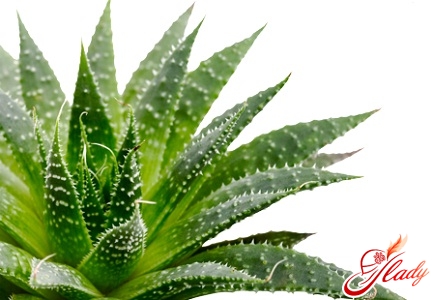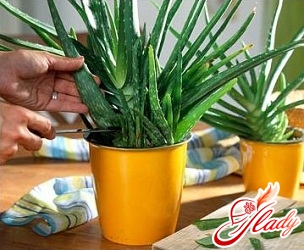 Very widespread indoora plant that is famous for its incredible healing properties, has become an aloe flower, the care of which is not very difficult. The name of this amazing plant takes its roots from the Arabic "alloeh", this word means "bitter plant". Sometimes the genus of aloe is classified as linear, but most scientists tend to believe that aloe belongs to the family of asphodel. This genus combines about one hundred species of plants of the succulent family, which are most common in the Arabian Peninsula, on the island of Madagascar, and also in the African savannas and steppes. The aloe plant is interesting because its species diversity amazes imagination. Most of them are perennials (not without reason the flower received its second name - the century-old one), but there are also shrub forms, tree-like and, strange as it may seem, lianas. In the world there are both miniature and giant species of aloe. The leaves of this plant are usually bessper, elongated, thick and juicy. At the edges of the leaves are soft spines. There are also such kinds of aloe, which do not form a stem and therefore all look like Haworthia. On this occasion, both plants are often confused with each other. In its historic homeland aloe produces flowers every year. A long flower stem, reaching 80 cm, is formed from the sinuses. At the end of the peduncle yellow, orange, white or red flowers bloom, which are neatly collected in spicate or racemose inflorescences. Even if you are caring for the aloe plant by all rules, it will still bloom extremely rarely in the indoor environment. In a pot, aloe can survive from 5 to 20 years, depending on the species and the literacy of care for the plant.
Very widespread indoora plant that is famous for its incredible healing properties, has become an aloe flower, the care of which is not very difficult. The name of this amazing plant takes its roots from the Arabic "alloeh", this word means "bitter plant". Sometimes the genus of aloe is classified as linear, but most scientists tend to believe that aloe belongs to the family of asphodel. This genus combines about one hundred species of plants of the succulent family, which are most common in the Arabian Peninsula, on the island of Madagascar, and also in the African savannas and steppes. The aloe plant is interesting because its species diversity amazes imagination. Most of them are perennials (not without reason the flower received its second name - the century-old one), but there are also shrub forms, tree-like and, strange as it may seem, lianas. In the world there are both miniature and giant species of aloe. The leaves of this plant are usually bessper, elongated, thick and juicy. At the edges of the leaves are soft spines. There are also such kinds of aloe, which do not form a stem and therefore all look like Haworthia. On this occasion, both plants are often confused with each other. In its historic homeland aloe produces flowers every year. A long flower stem, reaching 80 cm, is formed from the sinuses. At the end of the peduncle yellow, orange, white or red flowers bloom, which are neatly collected in spicate or racemose inflorescences. Even if you are caring for the aloe plant by all rules, it will still bloom extremely rarely in the indoor environment. In a pot, aloe can survive from 5 to 20 years, depending on the species and the literacy of care for the plant.
Healing properties of aloe
Since time immemorial, humanity hasunusual therapeutic properties of aloe. This plant was widely used not only by the inhabitants of ancient Egypt, but also by the Greeks and Romans thousands of years ago. Juice "century" and aloe vera has special healing properties. This remedy is successfully used in the treatment of purulent wounds, burns and other skin diseases. If the wound on the skin does not heal well, then fresh aloe leaves are applied to it in the form of compress, from which the skin is previously removed. Of the condensed aloe juice, a special preparation is prepared - a sabur that acts as a laxative and choleretic. Sabur improves digestion and increases appetite, has a pronounced anti-inflammatory and antimicrobial effect. Freshly squeezed aloe juice helps with inflammation of the gums, as well as with chronic gastritis. The healing properties of aloe are associated with the allantoin contained in it. This substance is concentrated in the leaves of plants. In addition to allantoin, aloe vera contains natural natural antioxidants - vitamins C and E, a complex of vitamins B and beta- carotene, which turns inside the human body into vitamin A. Healthier skin is heavily dependent on the presence of these nutrients. Specialists have developed a lot of medicines based on aloe juice. In addition to medicines, useful raw materials are used in balms, shampoos, gels and creams successfully used in cosmetology. If you carry out aloe care at home, then you can easily prepare a healing tincture from the plant with your own hands. The recipe for fortifying tincture is quite simple: the leaves of aloe must be thoroughly crushed, take half a glass of raw materials and add ¾ cups of honey to it. The mixture is infused for three days in a dark place. To the infusion should be added 3 cups of red wine and again sent to a dark place to insist one more day. So, the healing potion is ready! Tincture should be taken three times a day before meals for 1 tablespoon. It should be specially noted that the use of preparations based on aloe requires caution! Do not use this medication without a doctor's recommendation. Remember, only two kinds of aloe - Aloe arborescens (aloe tree) and Aloe vera show healing properties. In order to understand how to properly care for aloe, you need to study at least the most common plant species.
Types of Aloe
The most common type of aloe is Aloearborescens (Aloe vera), which is better known as a medicinal plant. The aloe vera helps to grow amazing leaves used in the treatment of gastric diseases, cuts and various inflammations. Even in the distant past it began to be used as a remedy. The century-old looks like a branching shrub that grows well both in width and height. In addition, the plant gives numerous side shoots. Tree aloe has juicy narrow leaves up to 20-30 cm long, with soft spines at the edges. With good care of the plant, aloe grows very quickly to 30-100 cm (although in nature aloe can reach 3-meter height). The only species common in the Mediterranean in the wild is Aloe vera-Aloe vera care for which allows you to grow an excellent cosmetic drug at home. This plant is a bush-shaped succulent with a shortened stalk and multiple shoots. From the leaves of the plant, dense groups of rosettes form. The leaves of aloe vera are lanceolate, juicy, greyish-green, slightly corrugated, with small denticles along their edges and reach a length of 50 cm. The nearest relatives of Aloe vera are Aloe indica Royle and Aloe barbadensis. Aloe vera juice is used for the manufacture of hair care products, as well as in numerous cosmetic preparations. How to care for aloe vera we will tell in more detail. Aloe aristata (Aloe virgin) are often confused with havortia due to the external similarity of these species. The leaves of the plant form a basal rosette with a diameter of up to 20 cm. The rosette consists of wide lanceolate leaves, along the edge of which there is a rim of white denticles. Whitish soft spines cover the lower surface of the leaves. A small plant Aloe variegata (Aloe variegated) reaches a height of not more than 30 cm and has an extremely short stem. The leaves of aloe variegated gather in a basal rosette and are arranged by three spiral, tightly twisted rows. The shape of the leaves of this species is triangular lanceolate, and on the leaves themselves stretch transverse white bands of irregular shape, at the edges of which in most cases small soft spines stretch. Aloe ferox (aloe horrible or awesome) is a powerful plant, whose single stem can reach 45 cm (in nature such a plant grows to 2 m). The plant has fleshy thick leaves, along the entire surface of which reddish-brown spines stretch, making aloe verrucose. Adult plants form spicate branched inflorescences consisting of red flowers. Aloe bellatula is a plant with a short stem, the narrow dark green leaves of which constitute an outlet and reach a width of 9-10 mm and a length of 10-13 cm. The leaves of the beautiful aloe on both sides are covered with white spots and miniature warts. On the edge of the sheet are small thorns. The flower-bud in this plant can reach 60 cm in height, it consists of the flowers of the bell-shaped red-coral color. If you want to green your apartment, you can safely use any of the cultivated species of succulent called aloe. Any plant will perfectly cope with the task of landscaping not only the space of the apartment, but also the terrace, the loggia, the shop window, etc. Aloe - an invariable attribute of rocky slides and miniature decorative compositions. So, we have got acquainted with the most common types of plants, and now we suggest that you familiarize yourself with how to take care of aloe. 
Aloe Care and Reproduction
Aloe care + reproduction starts with a choicethe right place to plant the plant. Succulents are light-loving plants, so the location of aloe must have enough sunlight. Plants feel good on the windowsills of the eastern and western windows. If your aloe is at the southern window, then in the hot summer hours it makes sense to shade the plant, which will protect it from direct sunlight. For aloe, care is very easy, because the plant is unpretentious to the temperature conditions of cultivation. For him there is absolutely no need to create a special microclimate. In winter, the flower can overwinter both under indoor conditions and at complete rest in a temperature regime of 10-15 ° C. How to care for aloe? It is enough to water it twice a week from the beginning of spring to the middle of October. Make sure that the earth fellow has time to dry out between waterings, otherwise there is no need for such care. In winter, the plant should be watered 1-2 times a month, it is advisable to use soft water. If the air in the room where the aloe is standing is overdried, then do not reduce the watering. However, while doing this, make sure that the water does not stagnate in the pan. Aloe can easily transfer dry air with sufficient watering, but the plant does not tolerate stuffiness. Fresh air for aloe is vital, so the room where the flower stands should be regularly ventilated. For an aloe flower, care can be supplemented with plant nutrition. From April to September, there is a period of active growth, during which time the aloe is fertilized once a month. Do this with fertilizer for succulents, cacti or a weak solution of any mineral fertilizer. During winter rest the plant does not need additional fertilizing. How to transplant aloe? Both young and adult aloe plants are transplanted. Every year, young aloe plants are transplanted, and adult plants are transplanted as needed - every 2-3 years. For the transplant, a special earth mix is prepared, which consists of two parts of a turf ground, one part of the leaf earth, one part humus and one part sand. In this mixture add charcoal and crumbs of red brick. This is enough to solve the problem correctly, how to transplant aloe. In principle, any kind of aloe can be grown as desired wholly on hydroponics. Another question that confronts many succulent owners is how to multiply aloe? You can use different ways of plant reproduction: use stem and apical cuttings, seeds, as well as radical shoots. Aloe seeds are commercially purchased in April, the air temperature should be about 22-24 ° C. If cuttings are used for propagation, then after cutting them, fresh sections are dried for 1-2 days, and then carefully powdered with crushed charcoal. Cuttings and radical shoots are planted in a substrate from one part of the peat and one part of the sand, thus deepening about 1 cm. During the propagation cuttings should not be sprayed or covered with a glass jar, and they can be seldom watered. However, from the moment when the cuttings take root, watering should be increased. Despite the fact that aloe is rarely affected by pests and diseases, it is still worthwhile to carefully monitor the plant. In the century, unexpected guests may come to live - scabbards. To help the pest comes a special gruel, which is made from soap and garlic with the addition of water. From time to time this mush is wiped with plant leaves, the scabbard of such "delicacy" does not tolerate. For aloe, nursing + breeding is a very simple activity, but the benefits and profit from these exercises are many, considering that the plant comes to the aid of a person with many health problems. In order to successfully cultivate a large part of the genus, it is sufficient to follow the general rules for the cultivation, transplanting and reproduction of succulent plants. We advise you to read:









